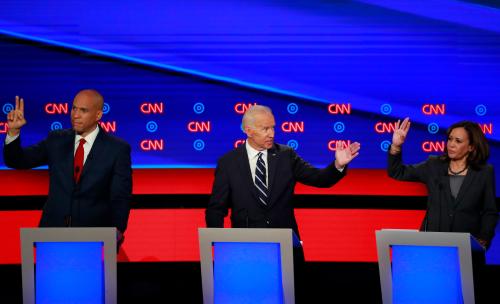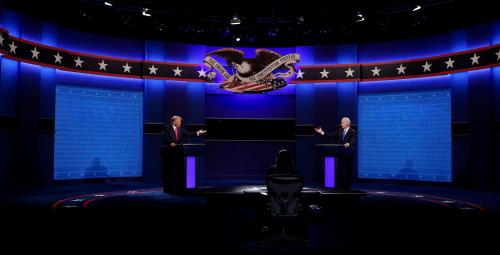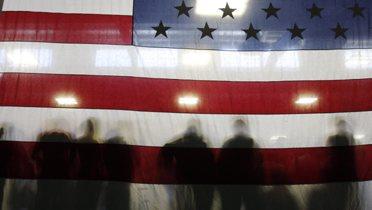A just-released survey from RealClear Opinion Research finds Democrats and Republicans poles apart on key issues. It suggests that left-leaning candidates enjoy an advantage as the Democratic presidential nomination contest begins but that they will have a hard time translating this advantage into a general election majority. And it provides new insight into public attitudes about capitalism, the free market, and the role of government.
To assess the public’s views on the relationship between government and the economy, the survey offered respondents four options ranging from the far-right to the far-left. The results are presented in Table 1:
Table 1: “When it comes to the U.S. economy, which statement comes closest to your own view?”
| Capitalism and free markets are too heavily regulated in the US today | 22% |
| Capitalism and free markets are generally working well in the US today | 36% |
| Capitalism and free markets are not working well in the US; stronger government regulation is needed | 15% |
| Capitalism and the free markets are broken in the US; stronger government control of markets such as health care, housing, and education is needed | 27% |
| Source: RealClear Opinion Research |
Slightly more than one-fifth of American voters identify with the push to slash government regulations, which has emerged as a major talking point in Republican accounts of the Trump administration’s accomplishments. Slightly more than one-quarter of the electorate endorses the outlook of left-leaning Democratic candidates who are urging a break with the Clinton/Obama approach to the economy. More than one third—a center-right plurality—are satisfied with the status quo and favor neither less nor more government intervention, while the path of moderate center-left reform comes in last, support by only one in seven voters.
There’s another way of looking at these results—as clues to the electoral performance of ideological coalitions. Simply put, a coalition of the far-right and the center-right commands a majority on economic management. So does a coalition of the center-right and the center-left. By contrast, only four in ten voters support a coalition of the center-left and the far-left on this issue, which should serve as a warning sign to those Democrats who hope to win in 2020 with a left-wing agenda while holding onto the suburban women they won over in 2018.
As one might imagine, partisan identification makes a big difference. Table 2 breaks down the results among Democrats, Republicans, and Independents.
Table 2: State of U.S. Economy by Party
| Dem | Rep | Ind | |
| Capitalism and free markets are too heavily regulated in the US today | 17% | 33% | 19% |
| Capitalism and free markets are generally working well in the US today | 26% | 47% | 39% |
| Capitalism and free markets are not working well in the US; stronger government regulation is needed | 18% | 9% | 16% |
| Capitalism and the free markets are broken in the US; stronger government control of markets such as health care, housing, and education is needed | 39% | 11% | 26% |
| Source: RealClear Opinion Research |
Table 2 reveals some important structural facts. First, Republicans are more united on economic ideology than are Democrats. In fact, 43 percent of Democrats identify with the center-right or far-right beliefs that dominate the Republican coalition.
Second, the far-left is by far the largest economic grouping in today’s Democratic party. If a single candidate seizes control of this faction, as Sen. Bernie Sanders did in 2016, he or she would have a good chance of winning the nomination against a divided field.
But third, more than six in ten Democrats do not identify with the far-left’s approach to government and the economy. In a head-to-head contest between the far-left and a more moderate candidate, the latter would have a good chance of prevailing, as Hillary Clinton did in 2016.
But isn’t it possible that the Democratic primary electorate will be to the left of the Democratic Party as a whole? Fortunately, the RealClear survey sheds light on the question by breaking out a separate category of likely Democratic primary participants. It turns out that on core economic issues, there is no significant difference between likely primary participants and other rank-and-file Democrats.
Table 3: State of U.S. Economy, Among Democrats
| All Dems | Likely Primary Dems | |
| Capitalism and free markets are too heavily regulated in the US today | 17% | 17% |
| Capitalism and free markets are generally working well in the US today | 26% | 23% |
| Capitalism and free markets are not working well in the US; stronger government regulation is needed | 18% | 19% |
| Capitalism and the free markets are broken in the US; stronger government control of markets such as health care, housing, and education is needed | 39% | 40% |
| Source: RealClear Opinion Research |
There’s a classic objection to this line of analysis: Many American voters are ideologically conservative but operationally liberal, so there’s more to be learned from their stances on particular issues than on their identification with broad ideological categories. Ideology counts, of course, which is why President Trump and the Republican Party are attacking Democrats who espouse “socialism.” (What this term means to Americans will be the subject of another article for this site.)
Still, high-profile issues are likely to matter more than ideology, and this survey helps us assess their potential impact. To what extent would respondents favor free or low-cost government provision of key services such as health care, community college, and child care? The results are arrayed in Table 4.
Table 4: Support for Provision of Public Goods by the U.S. Government
| All | Dem | Rep | Ind | |
| Free/low-cost health care | 69% | 86% | 46% | 68% |
| Free/low-cost community college | 41% | 53% | 24% | 42% |
| Free/low-cost child care | 31% | 42% | 16% | 31% |
| None of the above | 24% | 7% | 44% | 20% |
| Source: RealClear Opinion Research |
When it comes to public provision of services, not surprisingly, Democrats and Republicans are very different, with Independents in between. Still, health care is different: while it unites Democrats, it divides Republicans down the middle. This helps explain why congressional Republicans struggled with Obamacare and ultimately failed to repeal it and it also explains why healthcare played such an important role in Democratic victories in 2018
Public provision of health care is different in another way as well: it enjoys far more support among Democrats (and the public as a whole) than do equivalent programs for community college and child care. All Democratic candidates are likely to advocate an enhanced role for government in health care, while some have declined or will decline to follow Sen. Sanders on college and Sen. Warren on child care. The issue of higher taxes for these proposals may well be debated among Democratic contenders.
On these issues, as with ideology, there are no significant differences between likely Democratic primary participants and Democratic identifiers as a whole.
Table 5: Support for Provision of Public Goods by the U.S. Government, Among Democrats
| All Dems | Likely Primary Dems | |
| Free/low-cost health care | 86% | 87% |
| Free/low-cost community college | 53% | 56% |
| Free/low-cost child care | 42% | 41% |
| Source: RealClear Opinion Research |
The bottom line: Whatever may have been the case in the past, the outcome of the 2020 Democratic nominating contest appears likely to be determined by a primary electorate that represents the Democratic Party as a whole. If the party nominates someone who cannot defeat President Trump, it will have no one to blame but itself.







Commentary
New polling tracks 2020 voters on government and the economy
March 7, 2019